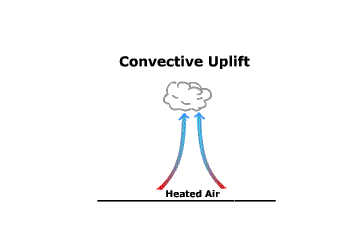CondensationCondensation is the phase change of water vapor into a liquid. During the condensation process, water molecules lose the 600 cal/gm of latent heat that were added during the evaporation process. When latent heat is released it is converted into sensible heat which warms the surrounding air. Warming the air increases its buoyancy and fuels the development of storms. Condensation takes place in the presence of condensation nuclei and when the air is nearly saturated. Water vapor is darting around so fast in the air that the molecules tend to bounce off one another without bonding. Even if a few pure water molecules were to collide and bind together, the surface tension created by such a tiny sphere is so great that it is extremely difficult for additional water molecules to become incorporated into the mass. Hence condensation nuclei act as a platform for condensation to take place, increasing the size of a droplet and decreasing surface tension. Water absorbent clay minerals and sea salt are good condensation nuclei. Sulfates and nitrates are water absorbent and are responsible for creating acid rain. The air must be at or near its saturation point for condensation to take place. Air can become saturated in two ways, 1) add water to the air by evaporation thus bringing it to saturation given its present temperature, or 2) cool the air to its dew point temperature. Cooling the air is the most common way for condensation to occur and create clouds. Air can be cooled through contact with a cold surface or by uplift. Contact cooling occurs when air comes in contact with a cooler surface and conduction transfers heat out of the air. Uplift Mechanisms
Adiabatic cooling occurs when air is uplifted from the surface causing the air to lose heat through the work of expansion. A parcel of air is uplifted when it initially gains heat from the surface causing convective uplift. When the air is warmed by the surface it will expand and become less dense relative to air that surrounds it. Being less dense than the air that surrounds it, the air becomes buoyant and begins to rise. Because atmospheric pressure decreases with height, the parcel of air expands and cools. If the air cools to its dew point temperature saturation occurs and condensation begins. The elevation above the surface where condensation begins is called the condensation level. |
 Figure 7.7 Convective uplift
Figure 7.7 Convective uplift